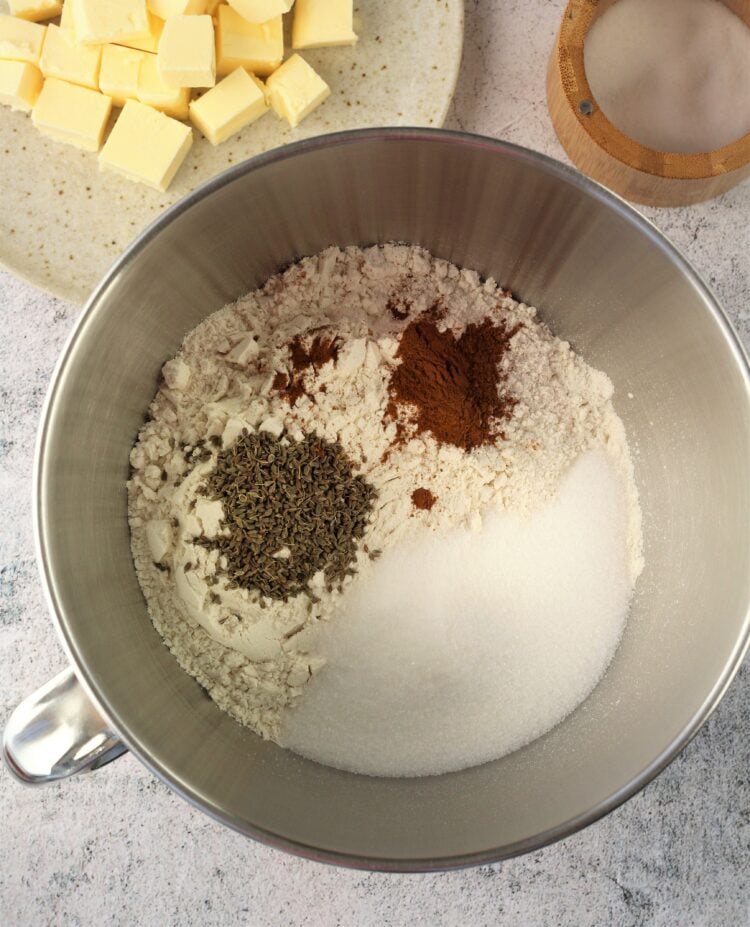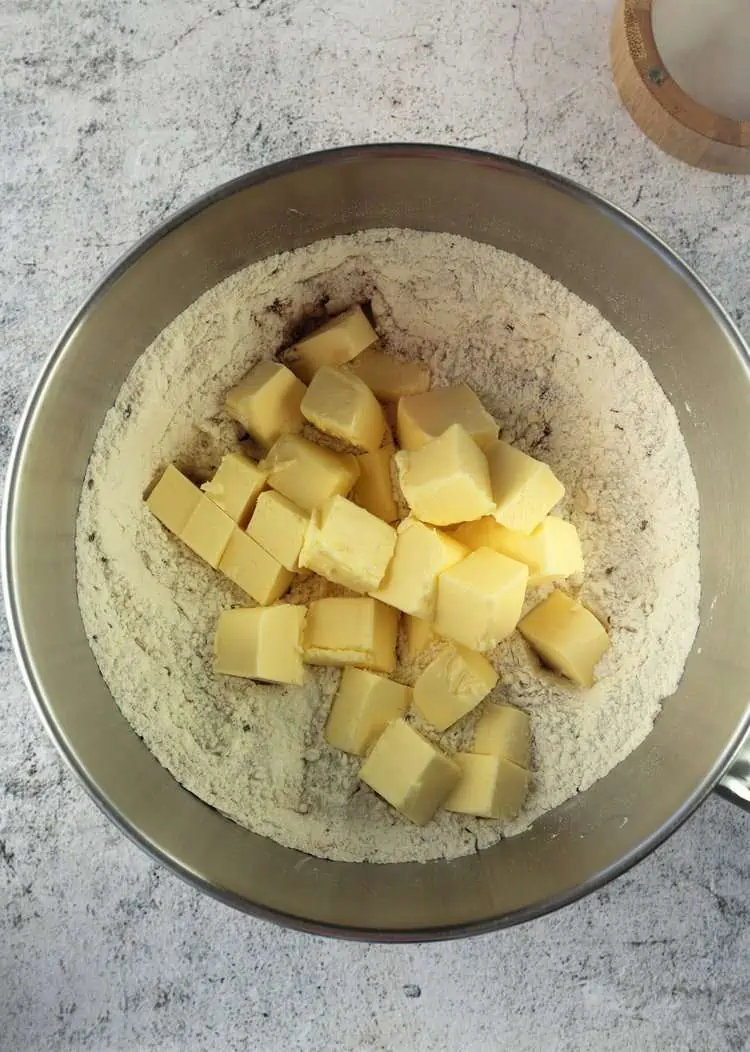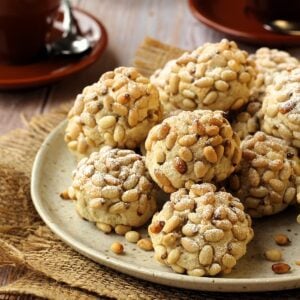Biscotti di San Martino are yeasted cookies, buttery and fragrant with anise seed and cinnamon. These traditional Sicilian cookies are enjoyed on November 11th, on St-Martin's Day, to celebrate the tasting of the new wine!

in Sicily, biscotti di San Martino are traditionally served with wine. However, in my opinion, they are also the perfect accompaniment to your coffee. These tasty cookies are buttery, not too sweet and flavored with anise seed and cinnamon.
Origin of Biscotti di San Martino
These anise seed cookies originated in the province of Palermo, Sicily and are also referred to as sammartinelli.
St-Martin's Day, celebrated November 11th, coincides with the tasting of the new wine as well as the end of the harvest. In fact San Martino is known as the patron saint of wine makers.
The saying goes a San Martino, ogni mosto è vino meaning on St-Martin's Day all wine must becomes wine. And therefore the crisp, dry version of these cookies are enjoyed with wine.

2 ways to enjoy San Martino Cookies
There are actually two ways to enjoy these cookies. The can be baked until soft and fluffy, similar to brioche. This version is commonly served cut in half and filled with sweetened ricotta cream, similarly to that used in my cannoli recipe.
The traditional method is a dry, crisp cookie that is baked longer and therefore perfect for dunking in a glass of wine such as sweet Moscato.
You'll find both baking methods in the recipe card at the end of this post.

Ingredient list

- All-purpose flour
- Granulated sugar
- Anise seed
- Cinnamon
- Salt
- Butter: chilled, unsalted
- Active Dry Yeast: 7 grams (1 packet)
- Water

The following are step by step instructions with images to guide you through this recipe. Please scroll to the end of this post for the detailed printable recipe card.
Step by Step Instructions
Make the dough
- Heat water until lukewarm, transfer to a bowl and add yeast. Let sit for 10 minutes, until foamy.
- In the bowl of your stand mixer fitted with the paddle attachment, combine the flour; sugar; anise seed; cinnamon; and salt.
- Add the cubed butter and process until the butter is incorporated in the flour mixture.
- Switch the paddle attachment for the dough hook, pour in the yeast mixture and knead on medium speed for 10 minutes or until smooth and elastic.
- If the dough is too dry, add a spoonful of water or two until all the flour is incorporated into the dough.
- Shape into a ball, cover and let rise for 3 hours in a warm and draft-free part of your kitchen.





Shape the cookies
- Line 2 baking sheets with parchment paper.
- After the dough has proofed, use a kitchen scale to divide it into 16, -60 gram balls.
- Keep the dough covered while you shape each cookie in order to prevent it from drying out.
- Roll each ball into a rope about 25 cm long and 2 cm wide.
- Do not flour your work surface. If the dough is dry and is difficult to roll, keep a small bowl of water handy and lightly wet your fingertips.
- Roll the rope onto itself in the shape of a snail.
- Tuck the end underneath in order to prevent the cookie from unraveling during baking.
- Continue with the remaining dough.
- Cover the baking sheets and let rise for one hour.



- Meanwhile, preheat your oven to 350 degrees F.
- Bake the cookies for 18-20 minutes until golden both underneath and on top.
- Transfer to a wire rack to cool before serving.

Recipe Notes
-Ground anise seed may be used in place of whole anise.
-Fennel seeds may be substituted for anise seed.
-These Sicilian cookies are traditionally prepared with lard, however I used butter instead.
-For the drier, crisper version of these cookies: bake at 400 degrees F for 10 minutes. Remove from the oven for 2 minutes, lower the temperature to 350 degrees F and bake for 10-15 minutes longer. If they begin to darken too much, cover loosely with a sheet of parchment or foil. Turn off the oven, leave the door slightly ajar and let cool completely before removing from the oven.
Definitely!
-Place the dry ingredients in a large mixing bowl.
-Cut in the chilled butter with your fingertips or a pastry cutter.
-Pour in the yeast mixture and knead until until you have a smooth dough, about 10 minutes.
-Enjoy the soft baked cookies cut in half and covered with sweetened ricotta cream, as in this cannoli recipe.
-Serve the dry baked cookies with a glass of wine or sweet Moscato.
-Store the softer baked cookies, well sealed, at room temperature for up to 3 days. However, for the best texture they are best enjoyed the same day.
-Store the longer baked, dry cookies at room temperature fo up to 5 days.
-Freeze San Martino cookies (both varieties), well wrapped, for up to one month.

Did you try this recipe?
Let me know how much you enjoyed it by rating it in the recipe card below!
*****
Check out more traditional Sicilian cookie recipes!
- Tetù (Sicilian Chocolate Spice Cookies)
- Cuccidati-Sicilian Fig Cookies
- Sicilian Lemon Anise Taralli
- Easy Anise Biscotti Recipe
- Italian Breakfast Cookies
- Biscotti Regina (Sicilian Sesame Seed Cookies)
- 3-Ingredient Hazelnut Cookies
- Sicilian Easter Cookies with Eggs

Biscotti di San Martino Recipe
Ingredients
- 1 packet active dry yeast 7 grams
- ¾ cup + 2 tbsp. water
- 4 cups all-purpose flour
- ½ cup granulated sugar
- 2 teaspoon anise seeds
- 1 teaspoon cinnamon
- ¼ teaspoon salt
- ½ cup unsalted butter cold, cut into cubes
Instructions
Prepare the dough
- Heat water until lukewarm, transfer to a bowl and add yeast. Let sit for 10 minutes, until foamy.
- In the bowl of your stand mixer fitted with the paddle attachment, combine the flour; sugar; anise seed; cinnamon; and salt.
- Add the cubed butter and process until the butter is incorporated in the flour mixture.
- Switch the paddle attachment for the dough hook, pour in the yeast mixture and knead on medium speed for 10 minutes or until smooth and elastic.
- If the dough is too dry add a spoonful of water or two until all the flour is incorporated into the dough. Shape into a ball, cover and let rise for 3 hours in a warm and draft-free part of your kitchen.
Shape the cookies
- Line 2 baking sheets with parchment paper.
- After the dough has proofed, use a kitchen scale to divide it into 16, -60 gram balls. Keep the dough covered while you shape each cookie in order to prevent it from drying out.
- Roll each ball into a rope about 25 cm long and 2 cm wide.
- Do not flour your work surface. If the dough is dry and is difficult to roll, keep a small bowl of water handy and lightly wet your fingertips.
- Roll the rope onto itself in the shape of a snail. Tuck the end underneath in order to prevent the cookie from unraveling during baking.
- Continue with the remaining dough. Cover the baking sheets and let rise for one hour.
Bake
- Meanwhile, preheat your oven to 350 degrees F.
- Bake the cookies for 18-20 minutes until golden both underneath and on top. Transfer to a wire rack to cool before serving.
Notes
-Fennel seeds may be substituted for anise seed.
-Lard is traditionally used in these cookies, however I used butter instead.
-For the drier, crisper version of these cookies: bake at 400 degrees F for 10 minutes. Remove from the oven for 2 minutes, lower the temperature to 350 degrees F and bake for 10-15 minutes longer. If they darken quickly, cover loosely with a sheet of parchment or foil. Turn off the oven, leave the door slightly ajar and let cool completely before removing from the oven. Can these cookies be made without a stand mixer? -Place the dry ingredients in a large mixing bowl.
-Cut in the chilled butter with your fingertips or a pastry cutter.
-Pour in the yeast mixture and knead until until you have a smooth dough, about 10 minutes. To serve -Enjoy the soft baked cookies cut in half and covered with sweetened ricotta cream, as in this cannoli recipe.
-Serve the dry baked cookies with a glass of wine or sweet Moscato. Storage -The softer baked cookies can be stored, well sealed, at room temperature for up to 3 days. However, for the best texture they are best enjoyed the same day.
-The longer baked, dry cookies can be kept at room temperature fo up to 5 days.
-San Martino cookies (both varieties) can be frozen, well wrapped, for up to one month.






Nadia Fazio
I can't get over how flavorful these cookies were. It's the first time, and not the last, that I baked with anise seed and we all enjoyed them!
Joanna
Hi Nadia, I just came across this recipe while looking for a recipe for ciambelle di San Cataldo. Though I'm not sure if you have one I had to visit your site just for the name - my beloved Nonna called us bedu, another form of Bedda, probably with an Arabic twist. I've so enjoyed looking at all your recipes but almost cried when I came across this one. Every year I was front and center when these were put on the table. I ABSOLUTELY LOVED THEM as a child and haven't had them for many years. Planning to make them soon, but just wanted to say thank you for bringing a lovely memory of my beautiful childhood back to me. In keeping the foods and memories alive all of the amazing people who have formed us into the people we are today remain vital and alive as well. It is the least we can do for those who made sure to shower us with love and COOKIES!
Again, thank you! Joanna
Nadia
Hello Joanna, actually I do not have a recipe for ciambelle di San Cataldo but I am curious to know what type of dessert this is? I do hope you try out the biscotti di San Martino and let me know how they turn out. Isn't it wonderful when a recipe evokes childhood memories? Thank you very much for your kind words!
Frank | Memorie di Angelina
These sound and look lovely, Nadia! I'm. not much of a baker, but even so I may give these a go. Anise and cinnamon make a lovely combination.
Nadia
Hello Frank, they really are so tasty. Even I was surprised at much I enjoyed the anise seed flavor! And they really were a no brainer to make. Hope you give them a try!